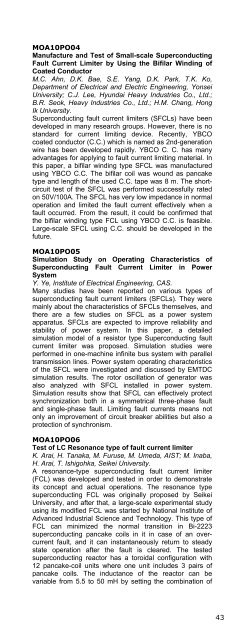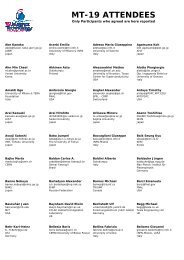Click here to download the abstract booklet in pdf format - MT19 - Infn
Click here to download the abstract booklet in pdf format - MT19 - Infn
Click here to download the abstract booklet in pdf format - MT19 - Infn
Create successful ePaper yourself
Turn your PDF publications into a flip-book with our unique Google optimized e-Paper software.
MOA10PO04<br />
Manufacture and Test of Small-scale Superconduct<strong>in</strong>g<br />
Fault Current Limiter by Us<strong>in</strong>g <strong>the</strong> Bifilar W<strong>in</strong>d<strong>in</strong>g of<br />
Coated Conduc<strong>to</strong>r<br />
M.C. Ahn, D.K. Bae, S.E. Yang, D.K. Park, T.K. Ko,<br />
Department of Electrical and Electric Eng<strong>in</strong>eer<strong>in</strong>g, Yonsei<br />
University; C.J. Lee, Hyundai Heavy Industries Co., Ltd.;<br />
B.R. Seok, Heavy Industries Co., Ltd.; H.M. Chang, Hong<br />
Ik University.<br />
Superconduct<strong>in</strong>g fault current limiters (SFCLs) have been<br />
developed <strong>in</strong> many research groups. However, t<strong>here</strong> is no<br />
standard for current limit<strong>in</strong>g device. Recently, YBCO<br />
coated conduc<strong>to</strong>r (C.C.) which is named as 2nd-generation<br />
wire has been developed rapidly. YBCO C. C. has many<br />
advantages for apply<strong>in</strong>g <strong>to</strong> fault current limit<strong>in</strong>g material. In<br />
this paper, a bifilar w<strong>in</strong>d<strong>in</strong>g type SFCL was manufactured<br />
us<strong>in</strong>g YBCO C.C. The bifilar coil was wound as pancake<br />
type and length of <strong>the</strong> used C.C. tape was 8 m. The shortcircuit<br />
test of <strong>the</strong> SFCL was performed successfully rated<br />
on 50V/100A. The SFCL has very low impedance <strong>in</strong> normal<br />
operation and limited <strong>the</strong> fault current effectively when a<br />
fault occurred. From <strong>the</strong> result, it could be confirmed that<br />
<strong>the</strong> bifilar w<strong>in</strong>d<strong>in</strong>g type FCL us<strong>in</strong>g YBCO C.C. is feasible.<br />
Large-scale SFCL us<strong>in</strong>g C.C. should be developed <strong>in</strong> <strong>the</strong><br />
future.<br />
MOA10PO05<br />
Simulation Study on Operat<strong>in</strong>g Characteristics of<br />
Superconduct<strong>in</strong>g Fault Current Limiter <strong>in</strong> Power<br />
System<br />
Y. Ye, Institute of Electrical Eng<strong>in</strong>eer<strong>in</strong>g, CAS.<br />
Many studies have been reported on various types of<br />
superconduct<strong>in</strong>g fault current limiters (SFCLs). They were<br />
ma<strong>in</strong>ly about <strong>the</strong> characteristics of SFCLs <strong>the</strong>mselves, and<br />
t<strong>here</strong> are a few studies on SFCL as a power system<br />
apparatus. SFCLs are expected <strong>to</strong> improve reliability and<br />
stability of power system. In this paper, a detailed<br />
simulation model of a resis<strong>to</strong>r type Superconduct<strong>in</strong>g fault<br />
current limiter was proposed. Simulation studies were<br />
performed <strong>in</strong> one-mach<strong>in</strong>e <strong>in</strong>f<strong>in</strong>ite bus system with parallel<br />
transmission l<strong>in</strong>es. Power system operat<strong>in</strong>g characteristics<br />
of <strong>the</strong> SFCL were <strong>in</strong>vestigated and discussed by EMTDC<br />
simulation results. The ro<strong>to</strong>r oscillation of genera<strong>to</strong>r was<br />
also analyzed with SFCL <strong>in</strong>stalled <strong>in</strong> power system.<br />
Simulation results show that SFCL can effectively protect<br />
synchronization both <strong>in</strong> a symmetrical three-phase fault<br />
and s<strong>in</strong>gle-phase fault. Limit<strong>in</strong>g fault currents means not<br />
only an improvement of circuit breaker abilities but also a<br />
protection of synchronism.<br />
MOA10PO06<br />
Test of LC Resonance type of fault current limiter<br />
K. Arai, H. Tanaka, M. Furuse, M. Umeda, AIST; M. Inaba,<br />
H. Arai, T. Ishigohka, Seikei University.<br />
A resonance-type superconduct<strong>in</strong>g fault current limiter<br />
(FCL) was developed and tested <strong>in</strong> order <strong>to</strong> demonstrate<br />
its concept and actual operations. The resonance type<br />
superconduct<strong>in</strong>g FCL was orig<strong>in</strong>ally proposed by Seikei<br />
University, and after that, a large-scale experimental study<br />
us<strong>in</strong>g its modified FCL was started by National Institute of<br />
Advanced Industrial Science and Technology. This type of<br />
FCL can m<strong>in</strong>imized <strong>the</strong> normal transition <strong>in</strong> Bi-2223<br />
superconduct<strong>in</strong>g pancake coils <strong>in</strong> it <strong>in</strong> case of an overcurrent<br />
fault, and it can <strong>in</strong>stantaneously return <strong>to</strong> steady<br />
state operation after <strong>the</strong> fault is cleared. The tested<br />
superconduct<strong>in</strong>g reac<strong>to</strong>r has a <strong>to</strong>roidal configuration with<br />
12 pancake-coil units w<strong>here</strong> one unit <strong>in</strong>cludes 3 pairs of<br />
pancake coils. The <strong>in</strong>ductance of <strong>the</strong> reac<strong>to</strong>r can be<br />
variable from 5.5 <strong>to</strong> 50 mH by sett<strong>in</strong>g <strong>the</strong> comb<strong>in</strong>ation of<br />
<strong>the</strong> series and paralleled connections of those units. One<br />
comb<strong>in</strong>ation <strong>in</strong> three-parallel and four-series mode makes<br />
a 200 A class FCL. The test result us<strong>in</strong>g 50 Hz alternat<strong>in</strong>g<br />
current shows <strong>the</strong> current <strong>in</strong>creases exponentially <strong>to</strong> a<br />
saturated level of approximately 240 A, 1.3 times of steady<br />
state current level, while it can be estimated <strong>to</strong> be beyond<br />
1000 A <strong>in</strong> <strong>the</strong> case of us<strong>in</strong>g no FCLs. The time constant <strong>to</strong><br />
reach <strong>the</strong> saturation can be def<strong>in</strong>ed by <strong>the</strong> specifications of<br />
<strong>the</strong> arrester voltage and <strong>the</strong> normal voltage level <strong>in</strong> <strong>the</strong><br />
superconduct<strong>in</strong>g reac<strong>to</strong>r, which was experimentally<br />
measured and confirmed also us<strong>in</strong>g <strong>the</strong> FCL <strong>in</strong> a different<br />
connection of those units.<br />
MOA10PO07<br />
Current Limit<strong>in</strong>g Characteristics of Inductive Type<br />
SCFCL with ZnO Device and Resis<strong>to</strong>r <strong>in</strong> Parallel<br />
Y. Shirai, T. Morimo<strong>to</strong>, K. Furushiba, M. Shiotsu, Kyo<strong>to</strong><br />
University; K. Fushiki, J. Baba, T. Nitta, The University of<br />
Tokyo.<br />
Superconduct<strong>in</strong>g Fault Current Limiters (SCFCLs) can be<br />
classified <strong>in</strong><strong>to</strong> two types by <strong>the</strong> current limit<strong>in</strong>g impedance,<br />
that is, <strong>in</strong>ductive-type (L-type) and resistive-type (R-type)<br />
SCFCL. Both types have merits and demerits each o<strong>the</strong>r.<br />
The L-type SCFCL has good features <strong>in</strong> current limit<strong>in</strong>g<br />
and recovery characteristics. The R-type one can consume<br />
<strong>the</strong> excessive energy of genera<strong>to</strong>rs at a fault and it can<br />
improve power system stability. In this paper, we proposed<br />
a new FCL system which consists of a L-type SCFCL <strong>in</strong><br />
parallel with a resis<strong>to</strong>r and a ZnO device. The proposed<br />
system has good features of both L- and R-type ones. A<br />
model system was made and studied experimentally. The<br />
ZnO device is off-state <strong>in</strong> stand-by mode. When a fault<br />
occurs, <strong>the</strong> SCFCL turns <strong>in</strong><strong>to</strong> current limit<strong>in</strong>g mode and has<br />
high impedance. The voltage across <strong>the</strong> SCFCL exceeds a<br />
threshold voltage of <strong>the</strong> ZnO device. Dur<strong>in</strong>g one cycle of<br />
<strong>the</strong> voltage, <strong>the</strong> ZnO device is on-state around <strong>the</strong> peak of<br />
<strong>the</strong> voltage, and <strong>the</strong> current flows through both <strong>the</strong> SCFCL<br />
and <strong>the</strong> resis<strong>to</strong>r. A certa<strong>in</strong> amount of excessive energy is<br />
dissipated <strong>in</strong> <strong>the</strong> resis<strong>to</strong>r. The ZnO device is off-state<br />
around <strong>the</strong> peak of <strong>the</strong> current which is suppressed only by<br />
<strong>the</strong> L-type SCFCL. F<strong>in</strong>ally <strong>the</strong> proposed FCL system<br />
<strong>to</strong>ggles L-type and L+R-type <strong>in</strong> a cycle. Relations among<br />
<strong>the</strong> threshold voltage, <strong>the</strong> current limit<strong>in</strong>g impedance and<br />
<strong>the</strong> resistance of <strong>the</strong> resis<strong>to</strong>r were discussed. It was<br />
confirmed <strong>the</strong> proposed FCL system represents desirable<br />
current limit<strong>in</strong>g characteristics.<br />
MOA10PO08<br />
Study of a novel high-Tc superconduct<strong>in</strong>g fault current<br />
limiter<br />
Z. Zhang, L. Xiao, Institute of Electrical Eng<strong>in</strong>eer<strong>in</strong>g, CAS.<br />
Withdrawn.<br />
MOA10PO09<br />
Investigation of Electrical Insulation Characteristics <strong>in</strong><br />
<strong>the</strong> Simulated Quench Conditions of HTS FCL<br />
B-Y. Seol, K. Nam, C. Lee, Electro-Mechanical Research<br />
Institute, Hyundai Heavy Industries Co., LTD.<br />
Withdrawn.<br />
MOA10PO10<br />
Design and Test of High-TC Superconduct<strong>in</strong>g Coils for<br />
a Three-Phase 10.5kV/1.5kA Fault Current Limiter<br />
Z. Wang, J. Zhang, D. Zhang, H. Li, Y. Guan, Q. Bao, L.<br />
L<strong>in</strong>, L. Xiao, ASCL, IEE.<br />
The design of High Temperature Superconduct<strong>in</strong>g (HTS)<br />
coils for a three-phase 10.5kV/1.5kA HTS fault current<br />
limiter (FCL) is described. It is well known that <strong>the</strong> Ic of<br />
HTS materials is very sensitive <strong>to</strong> <strong>the</strong> orientation of fields.<br />
43 MT-19 2005, Genova



